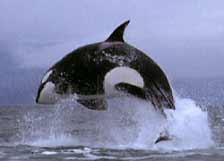|
SAVING
THE ORCAS OF PUGET SOUND
 Orcas
are the totem species of northwest Washington and coastal
British Columbia. Their playful leaping, diving, spyhopping
images
adorn coffee mugs, t-shirts, boats, beer bottles, kayaks,
long-houses, totem poles, baseball caps, sculptures and ferry
landings. And if a group of school children in Washington
State have their way, orcas may soon grace the state's licence
plate as well. The killer whale is a mainstay of our tourist
economy, our love of the ocean, and our sense of brotherhood
with other species. Without orcas, human life in the Pacific
Northwest would be greatly impoverished. Orcas
are the totem species of northwest Washington and coastal
British Columbia. Their playful leaping, diving, spyhopping
images
adorn coffee mugs, t-shirts, boats, beer bottles, kayaks,
long-houses, totem poles, baseball caps, sculptures and ferry
landings. And if a group of school children in Washington
State have their way, orcas may soon grace the state's licence
plate as well. The killer whale is a mainstay of our tourist
economy, our love of the ocean, and our sense of brotherhood
with other species. Without orcas, human life in the Pacific
Northwest would be greatly impoverished.
The
future may be without orcas if action is not taken soon.

Data
collected by the Center for Whale Research
|
A
combination of PCB poisoning, declines in salmon (a favorite
orca prey), general ecosystem deterioration, growing whale
watching pressure, and the lingering effects of many whales
being captured for display in the 1960's and 70's, has caused
the population to plummet almost 20% in the since 1996. Add
in the constant threat of oil spills, boat collisions, fishing
net entanglement, strandings, and disease, and you have a
recipe for the extinction of one of North America's most magnificent
and charismatic species.
The
small size of the population and its recent catastrophic decline
qualify it for listing as "endangered" under the strict scientific
criteria established by the International Union for the Conservation
of Nature. It was listed as "threatened" by the British Columbian
government in 1999, but still lacks federal protection in
the United States.

With
its current population trend, the Puget Sound killer whale
will likely go extinct within 33 to 121 years. The median
time to extinction is 74 years. If habitat conditions
improve, it has good chance of surviving over 300 years.
For more information, see the Center's July, 2001 Population
Viability Analysis. |
USING
SCIENCE AND LAW TO PROTECT KILLER WHALES
To
help save Puget Sound's orcas (known to scientists as "southern
resident killer whales"), the Center for Biological Diversity
brought together a population ecologist, a toxicologist, and
an endangered species activist to study its life history,
habitat needs, population trends, and threats to its existence.
We also brought in a lawyer to review legal mandates for the
protection of imperiled species. This diverse
group produced the first ever population viability
analysis (PVA) for a population of killer whales. The PVA,
a complex computer model, showed that if current population
trends continue, the Puget Sound population will go extinct
within 100 years, possibly as soon as 30 years. Even if birth
and death rates are averaged out over the past several decades,
the orca's risk of extinction is greater than 50% in the next
100 years and 99% in the next 200 years. Just one or two oil
spills, strandings, or disease outbreaks per century dramatically
increased the risk of extinction.

When
meeting each other after a long absence, killer whale
pods sometimes form a ritualistic line and touch noses.
|
The
Center's population ecologist, Dr. Martin Taylor,
traveled to Rome in June,
2001 to help the International Whaling Commission develop
similar models to predict the impact of habitat loss on cetacean
(whales, dolphins, and porpoises) populations around the world.
Considering
the high probability of extinction, the Center's science and
legal team next developed a comprehensive
petition to list the Puget Sound whales as "endangered"
under the U.S. Endangered Species Act (ESA). The ESA is our
nation's strongest environmental law. It mandates federal
recovery plans for all listed species, prohibits killing and
harassment, establishes protected "critical habitat" areas,
and ensures that all federally permitted activities (shipping,
fishing quotas, development permits, etc.). Listing under
the ESA is the first step to recovery, not only for the orcas,
but the entire Puget Sound ecosystem which is deteriorating
under the pressure of overfishing, pollution, coastal development,
upstream logging, and marine traffic.
The
petition was filed with the National Marine Fisheries Service
by the Center on May 1, 2001, on behalf of a coalition including
the Center for Whale Research, the Whale Museum, Ocean Advocates,
Washington Toxics Coalition, Orca Conservancy, American Cetacean
Society, Friends of the San Juans, People for Puget Sound,
Cascade Chapter of the Sierra Club, Project Sea Wolf and former
Washington Secretary of State, Ralph Munro.
STEPS
TOWARD RECOVERY
An
initial finding on the ESA petition is due August 1, 2001.
If the Fisheries Service determines the petition is based
on solid scientific data, it will have until May 1, 2002 to
issue a formal listing proposal and until May 1, 2003 to finalize
federal protection.
Once
the listing is complete, the Center will help develop a federal
recovery plan for the orca. In the meantime, we are working
to identify important areas for potential designation as critical
habitat. These will include areas used by the whales, but
also by their prey species and the entire food chain linking
whales to salmon, salmon to herring and copepods, both of
these to eel grass beds, and eel grass beds to water quality
and sea bed conditions.
The
development of the listing petition provided an opportunity
for scientists and environmental activists to draft an initial
set of orca conservation
recommendations. Over the next several years the
Center will work with its conservation partners to flesh out
and expand these recommendations, hoping to form the basis
of conservation efforts at the county, state, federal and
international levels.
|

